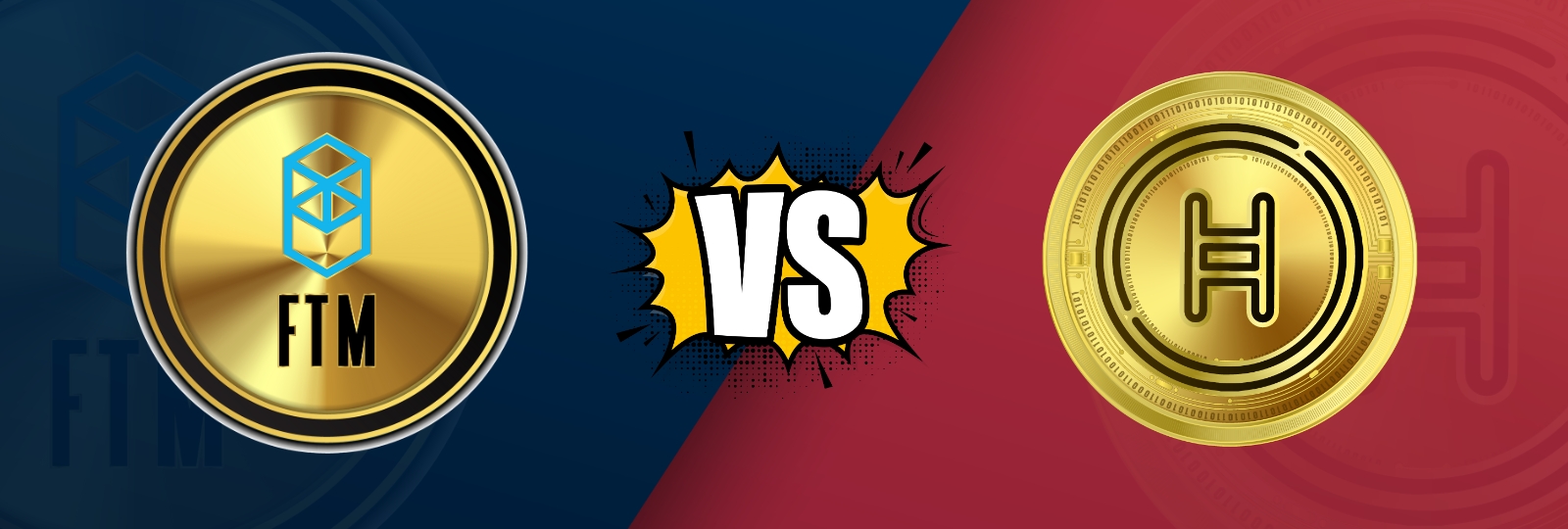We witnessed the enormous growth of blockchain technology and the services it enabled in the decade before the 2020s. However, 2021 and 2022 have been years of new hybrid models remarkably similar to blockchain but quite different and have challenged blockchain technology. Hedera Hashgraph and Fantom, two of the most prominent use cases of these technologies, are not based on blockchain. Still, both provide remarkably similar services to the blockchain, faster than blockchain and without any of its drawbacks.
Find out if Hedera (HBAR) or Fantom (FTM) is the best cryptocurrency by reading on!
What is Fantom?
Fantom is a well-known layer 1 blockchain noted for its decentralization, high transaction speeds, and low transaction fees. Fantom is supported by a consensus method called Lachesis, which enables it to process large volumes of transactions at a relatively low cost. This has allowed Fantom to gain notoriety quickly and be compared to other “Ethereum Killers” like Solana and Avalanche.
Fantom Ecosystem: Smart hub for decentralized Finance
Fantom has a robust DeFi ecosystem with a diverse spectrum of dApps that saw their own small bull run in 2021, thanks partly to one of Fantom’s major contributors Andre, who created protocols like Yearn Finance.
There was a lot of unwarranted FUD when Andre retired from Fantom Development. Still, more recently, there have been rumors that he might come back, which would benefit the platform and its ecosystem.
Due to Fantom’s quick transactions and low fees, the DeFi ecosystem expanded quickly, luring throngs of eager investors. At its peak in 2022, the chain had a total value locked (TVL) of $8 billion, placing it among the largest blockchains by TVL.
Four fundamental ideas formed the foundation of the Fantom network:
- Modularity: The extremely flexible nature of Fantom’s modular architecture. Decentralized apps (dApps) built on Ethereum can be readily ported to the Fantom mainnet, which is run by Opera, the open-source blockchain that Fantom built to power its network.
- Scalability: Fantom apps are independent of one another. Therefore, network traffic generally only affects the performance and stability of a single application.
- Open source: The Fantom protocol’s underlying code, posted on Github, is available for anyone to run a node and modify.
- Security: The Lachesis consensus process, which the Fantom developers claim is faster, more secure, and scalable than the Classical and Nakamoto consensus systems, is used to safeguard Fantom.
Fantom contains everything required to create dApps that millions of users can use. Developers may design Web3 apps that are highly scalable, quick, and affordable thanks to Fantom’s distinctive architecture.
dApps from Ethereum and other blockchains can be simply migrated to Fantom because it is EVM compatible.
What is Hedera?
Hedera is a decentralized blockchain system that enables users to generate, store, and transfer data and value securely and effectively. Hedera is a public enterprise-grade network offering users total control over their dApps and data while upholding the highest security and energy efficiency standards.
Hedera provides a variety of services on the network, including the ability to create fungible and non-fungible tokens, such as NFTs, a consensus service that enables users to track assets along a supply chain, IP rights, identity credentials, and more, as well as the ability to create smart contracts using the Solidity and Vyper programming languages.
Hedera Ecosystem
Hedera has developed a vibrant ecosystem that enables users to access financial services without depending on centralized systems. It makes it simple for users to create and control their own tokens, decentralized applications, and smart contracts.
While Hedera’s DeFi ecosystem may not be as extensive as Fantoms by TVL, it does have a more reliable TVL that has continued to rise even during the current weak market, with Hedera’s TVL being valued at $26 million.
Fantom vs. Hedera: Which is better?
While both technologies have demonstrated their technology works, choosing between them takes a lot of work. Hedera has an advantage over Fantom in important areas because it has already created the technology for virtual voting and filed for a patent. Fantom still needs help incorporating new features. In general, the Hedera Hashgraph utility is inferior to Fantom.
However, Hedera Hashgraph’s utility is anticipated to increase with time and eventually surpass Fantom’s. Despite this, Hedera Hashgraph is utilized in transactions comparatively more often than Fantom, despite the latter’s relative youth.
Fantom is three times more decentralized than Hedera Hashgraph. This may suggest that HBAR is less reliable than Fantom, but it does not necessarily imply that Hedera Hashgraph is less secure.
Fantom and Hedera Hashgraph are proponents of self-custody. The fact that HBAR and FTM are both extensively accepted by at least one well-known cryptocurrency payment processor, such as CoinPayments, NOWPayments, and Coingate, reduces their need for centralized organizations for security.
Hedera runs current, crucial applications like COVID Vaccination Tracking, Medical Record Tracking, and other operational systems. Although Fantom likewise possesses intriguing technology, Hedera likely has greater long-term promise.
If we look at the price performance of both the giants, Fantom and Hedera, our system forecasts that as Fantom keeps setting new records, it will hit a high of $1.16 real soon, and by the end of the year, the FTM token might trade around $1.04 as per our FTM price prediction. The lowest price FTM can reach in the event of a bear market is $0.913497.
Our Hedera Hashgraph prediction indicates that the future coins could trade at $1.41 by 2030. If they invest at the current price and the token rises to $1.40 in value, investors might profit more than 2000%. If all goes according to plan and in favor of the HBAR coin, we anticipate the currency’s price to be around $46.45 in 2035. This coin might sell for as much as $63.88. The HBAR coin is expected to cost $55.16 on average.

